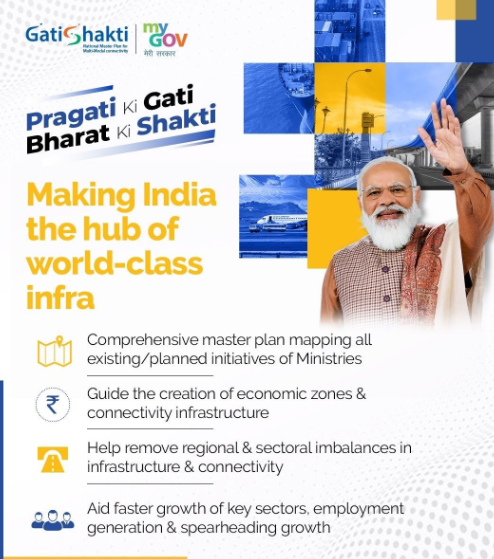National Logistics Policy
Syllabus:
- GS 3: Government Policies and intetventions
Why in the News?
India’s exports have been under focus due to government initiatives such as the National Logistics Policy and the PM Gati Shakti Plan, aimed at reducing the high logistics costs and for improving efficiency.
Introduction
- Transformation in the retail landscape is going on in India, driven by a growing middle class, increased digitalization and a booming e-commerce market.
- Changes in Government policies and technological innovations in logistic sector, aims at reducing logistics costs, which is essential for unlocking the potential of India’s overall retail growth.
PM Gati Shakti National Master Plan
- PM Gati Shakti National Master Plan was launched with the objective of improving infrastructure related to multimodal connectivity in various economic zones
- Approval: October 21, 2021, by Cabinet Committee on Finance for implementation.
7 Engines of Growth
- Seven vital industries are power, roads and railways ports waterways airports logistics of mass transport infrastructure.
- Supported by abundant water and drainage, IT networks, energy exports, and social services.
Goals
- Economics follows good logistical efficiency and smooth multimodal coordination.
- The New Economy focuses on rapid planning, financing and implementation enabled by technology.
Encouraging Digitalization
- Geographic information system (GIS) platform: developed by BISAG-N allows real-time flexibility.
- An integrated database simplifies planning and analysis by integrating information from multiple ministries and departments.
- Stakeholder Support User Access: Each ministry will have a login ID to regularly update their information.
- API Integration: To help stakeholders make better use of this digital platform, the Department of Logistics at the Ministry of Commerce and Industry will provide support.
Retail Revolution in India
- From $820 billion by 2023 to $2 billion by 2033 expected growth, India is about to witness retail revolution.
- Driven by the rise of digitization and the internet, e-commerce market in India is expected to reach $325 billion by 2030.
Logistics Drive
- Efficient logistics and supply chain management. Are factors on which the growth of e-commerce
- Currently, logistics costs around for 11-14% of India’s GDP, which is 8%. up from the global average.
- In the US, Europe and China, it costs around 8%,10% and 9% respectively.
Measures to reduce logistics costs
- To strengthen retailers’ gains shipping cost has to be reduced.
- To increase affordability for consumers, Reduction in freight costs is need of hour.
- Adoption of global best practices is essential to improve export efficiency and unlock the potential of the retail market.
Logistics Industry in India
- By 2029, India’s exports are expected to rise to $484.43 billion, with an annual growth rate of 8.8%.
- Government announced plans to improve infrastructure, streamlining operations and low-cost technology, to align with changing consumer habits.
National Logistics Policy (NLP)
- The government’s National Logistics Policy (NLP) create framework for appropriate policies to improve logistics performance.
- Aims to encourage innovation, standardization and investment, NLP aims to reduce costs and encourage data-driven decision-making.
Focus on Digitalization
- To reduce inefficiencies, the plan places greater emphasis on the digitization of logistics systems including information sharing, e-filing and real-time analytics
- With the development of ULIP, NLP hopes to connect all stakeholders into a single platform to increase communication and collaboration.
Global Best Practices
Germany
- Germany’s logistics’ industry is worldwide famous for its efficiency, backed by government facilities and a highly skilled workforce.
- The German model emphasizes on the importance of effective integration of different transport modes in improving efficency.
- The predictability and reliability of the logistics industry has increased with the use of advanced technologies such as data analytics, artificial intelligence (AI), and the Internet of Things (IoT).
Gati Shakti National Master Plan
- India aims to boost the logistics sector through the Gati Shakti National Master Plan, which has prioritized quality education and skill development in improving logistics sector.
- Improving warehouse standards is essential for logistics feasibility, Technological warehouses can reduce waste, save on storage costs, and improve inventory.
Warehouse Digitalization
- Use of Advanced technologies like robotics and AI, can streamline operations and increase productivity.
- Hi-tech warehouse is important for the e-commerce sector, enabling faster delivery and customer satisfaction and affordability.
Need for Skilled Workforce
- Logistics companies need professionals skilled in handling nascent technologies and systems.
- The Gati Shakti National Master Plan places great emphasis on the value of funding the training and development of logistics business plans.
Industry-academic Collaboration
- Universities and educational institutes can collaborate with industry to facilitate skills development, guarantee workforce to meet modern demands.
Socio-economic impact
- A robust export policy is necessary to improve the overall growth of the country and boost economic growth.
- The standard of living of millions of people can be raised by improving exports, creating more jobs.
- India can become major global trading hub, due to its advantageous location connecting East and West.
Conclusion
India can potential of its retail sector through logistics advancement, enabling country to achieve sustainable growth and economic success by adopting international best practices like germany, investing in infrastructure and hiring qualified personnel realizing the dream of Vikshit bharat by 2047.
Source: Indian Express
Mains Practice Question:
How national logistics policy transformed logistics Ecosystem in India, what are the challenges faced by logistics industry in India?





